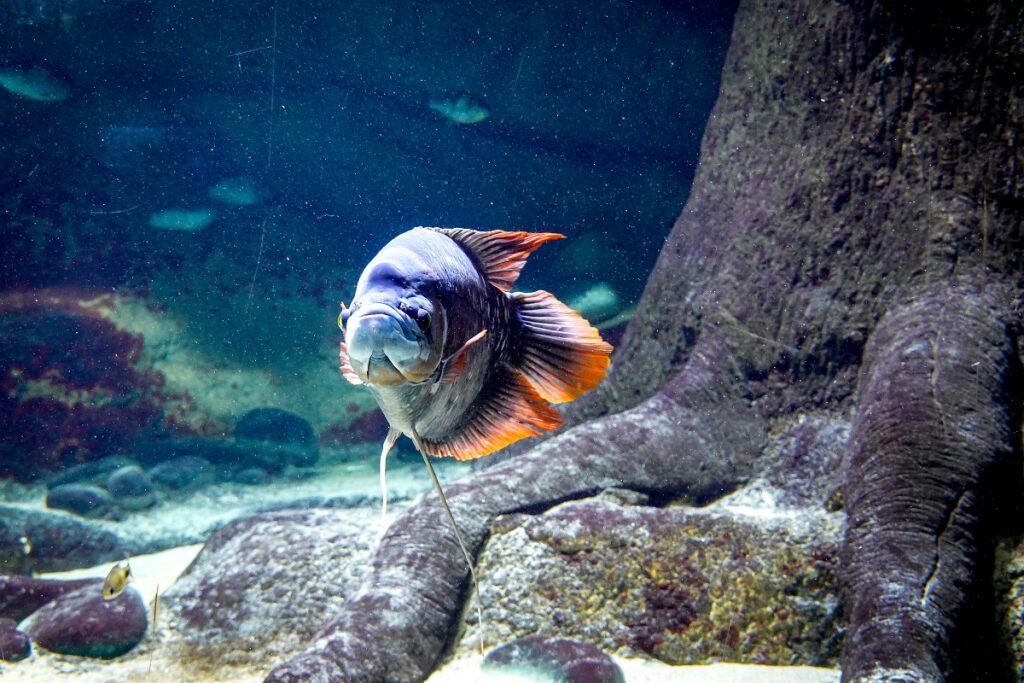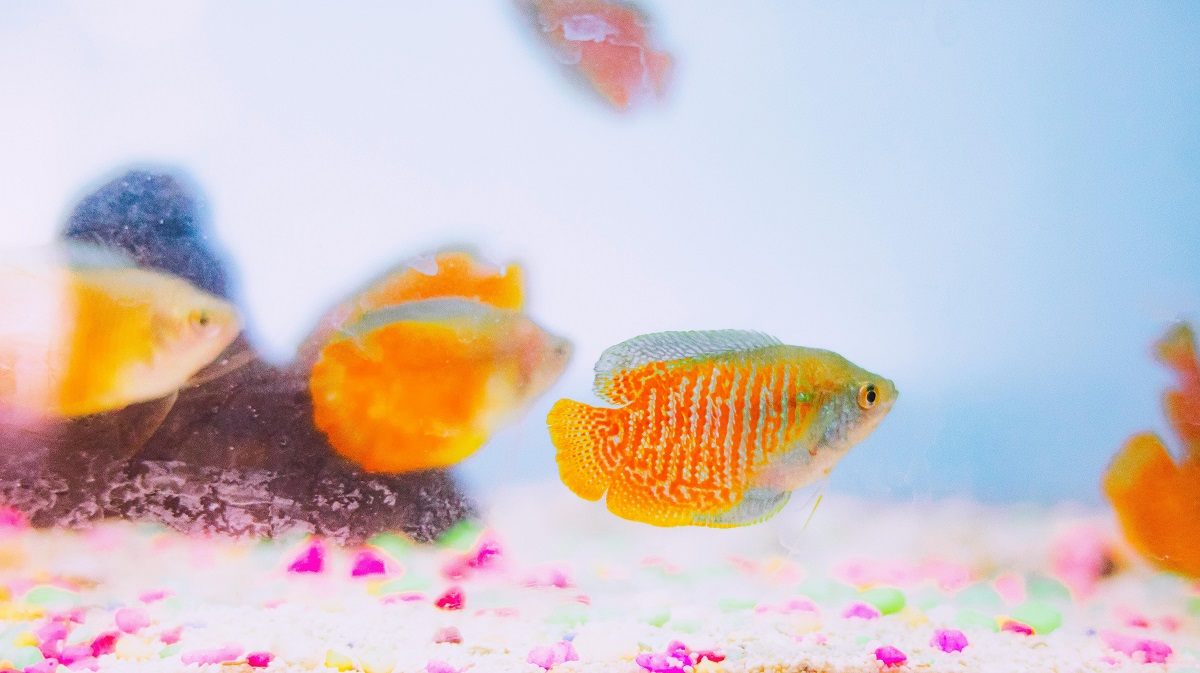Gourami fish are among the most popular species in the aquarium trade. Known for their vibrant colors, unique behavior, and adaptability, they make excellent pets for beginners and experienced aquarists. These freshwater fish originate from Asia and are commonly found in slow-moving rivers, swamps, and rice paddies. Their natural ability to adapt to diverse environments makes them a favorite for fish enthusiasts worldwide.
Physical Characteristics

| Feature | Details |
|---|---|
| Scientific Name | Varies by species (e.g., Trichogaster lalius for Dwarf Gourami) |
| Common Name | Gourami |
| Class | Actinopterygii (Ray-finned fishes) |
| Order | Anabantiformes |
| Family | Osphronemidae |
| Origin | Southeast Asia (Thailand, India, Indonesia, Malaysia, etc.) |
| Habitat | Slow-moving rivers, swamps, ponds, and rice paddies |
| Size | Ranges from 2 inches (Dwarf Gourami) to 28 inches (Giant Gourami) |
| Lifespan | 4–7 years (varies by species) |
| Diet | Omnivorous (algae, insects, plant matter, and small invertebrates) |
| Color Variations | Blue, red, gold, orange, pearl, green, and more |
| Behavior | Peaceful to semi-aggressive (depending on species) |
| Reproduction | Bubble nest builders (most species) |
| Special Features | Labyrinth organ for air-breathing |
| Aquarium Size | 10 gallons (small species) to 50+ gallons (large species) |
| Water Temperature | 75–82°F (24–28°C) |
| Water pH | 6.0–7.5 |
| Tank Compatibility | Suitable for community tanks with peaceful species |
Their bodies are typically oval-shaped with long, flowing fins. Most species have a labyrinth organ, which allows them to breathe atmospheric air. This unique adaptation helps them survive in oxygen-poor water.
The colors of gourami fish vary greatly. They can be shades of blue, red, orange, gold, and even iridescent. Their patterns include stripes, spots, and solid colors, making each species distinct.
Habitat and Distribution
Gourami fish are native to Southeast Asia. Several species are found in countries like Thailand, Indonesia, Malaysia, and India. They thrive in slow-moving waters such as rivers, swamps, ponds, and rice fields.
In the wild, gouramis prefer areas with dense vegetation. The plants provide shelter and breeding grounds. They are also essential to their diet as gouramis feed on algae and small aquatic organisms.
Behavior and Temperament
Gourami fish are generally peaceful and social. However, their behavior can vary depending on the species. Dwarf Gouramis are shy and prefer a calm environment, while species like the Blue Gourami can be territorial, especially during breeding.
Male gouramis often display aggressive tendencies when defending their territory or competing for a mate. Despite this, they are compatible with many other fish species in community tanks.
Gouramis are known for their curious nature. They often explore their surroundings and interact with other fish in the tank.
Popular Gourami Species
Dwarf Gourami (Trichogaster lalius)
Size: 2–4 inches
Color: Vibrant blue and red stripes
Behavior: Peaceful and shy
Ideal for small aquariums.
Pearl Gourami (Trichopodus leerii)
Size: 4–5 inches
Color: Iridescent pearl-like spots on their body
Behavior: Peaceful and social
Known for their elegance and beauty.
Giant Gourami (Osphronemus goramy)
Size: Up to 28 inches
Color: Pale pink or gray
Behavior: Territorial but calm in large tanks
Often kept in public aquariums.
Three-Spot Gourami (Trichopodus trichopterus)
Size: 4–6 inches
Color: Blue or gold with three distinctive spots
Behavior: Semi-aggressive during breeding
Easy to care for and hardy.
Kissing Gourami (Helostoma temminckii)
Size: 6–12 inches
Color: Pink or green
Behavior: Peaceful but territorial
Known for their “kissing” behavior.
Diet and Feeding
Gourami fish are omnivorous. In the wild, they eat a mix of algae, insects, and small invertebrates. In captivity, they thrive on a varied diet.
Commercial Fish Food: Flakes or pellets formulated for tropical fish are a staple for gouramis.
Live or Frozen Food: Offer brine shrimp, bloodworms, or daphnia for added nutrition.
Vegetables: Blanched spinach, zucchini, and peas can supplement their diet.
Algae: Gouramis naturally graze on algae in their environment.
Feed them twice a day in small portions to avoid overfeeding.
Breeding Gourami Fish
Breeding gouramis in captivity is relatively straightforward. Most species are bubble nest builders. Males create nests using bubbles and plant material at the water’s surface.
Steps to Breed Gourami Fish
Separate the Breeding Pair: Place a male and female in a separate breeding tank with plants and calm water.
Condition the Fish: Feed them a high-protein diet, such as live or frozen food, to prepare them for breeding.
Bubble Nest Construction: The male builds a nest. Once the nest is ready, he courts the female.
Egg Laying: The female lays eggs, which the male fertilizes. The male then places the eggs in the bubble nest.
Caring for Eggs: Remove the female after spawning to prevent her from eating the eggs. The male will guard the nest.
Hatching: The eggs hatch in 1–2 days. The fry becomes free-swimming after a few days.
Feed the fry with infusoria or liquid fry food until they are large enough to eat brine shrimp or finely crushed flakes.
Tank Setup and Care
Creating the right environment is crucial for the health and happiness of gourami fish.
Tank Requirements
Size: At least 10 gallons for small species; larger species need 50+ gallons.
Water Conditions: Maintain a temperature of 75–82°F (24–28°C) and a pH of 6.0–7.5.
Filtration: Use a gentle filter to keep the water clean. Gouramis prefer slow-moving water.
Decorations: Add plants, rocks, and driftwood to mimic their natural habitat.
Lighting: Moderate lighting is sufficient.
Maintenance Tips
Perform regular water changes (20–30% weekly).
Monitor water parameters to avoid stress or illness.
Avoid overcrowding the tank.
Common Health Issues
Gourami fish are generally hardy but can be prone to certain health issues:
Ich (White Spot Disease): Caused by parasites, it appears as white spots on the fish’s body. Treat with medication and by raising the water temperature slightly.
Fin Rot: A bacterial infection that causes fins to fray. Maintain clean water and treat with antibiotics if needed.
Bloating or Dropsy: This can occur due to poor diet or internal infections. Quarantine the fish and seek appropriate treatment.
Interesting Facts About Gourami Fish
Air-Breathing Ability: Gouramis have a labyrinth organ that allows them to breathe air, enabling them to survive in low-oxygen environments.
Kissing Gourami Behavior: Their “kissing” action is not a romantic gesture but a display of dominance.
Versatile Diet: Gouramis are not picky eaters and can adapt to various food sources.
Bubble Nest Builders: Males create intricate nests to protect their eggs and young.
Long Lifespan: With proper care, some gouramis can live up to 5–7 years in captivity.
Wide Range of Colors: Their vibrant hues make them a popular choice among aquarium enthusiasts.
Easy to Breed: Gouramis are one of the easiest fish species to breed in home aquariums.
Conclusion
Gourami fish are a testament to the beauty and diversity of aquatic life. Their vibrant colors, unique adaptations, and peaceful nature make them a favorite among fish enthusiasts. Whether you’re drawn to the graceful Pearl Gourami or the striking Dwarf Gourami, these fish never fail to captivate.
With proper care and attention, gouramis thrive in home aquariums, offering endless joy to their keepers. Their adaptability and charm make them one of the most remarkable freshwater fish species in the world.

